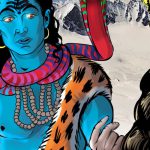Hombres y Héroes
Regions: Mexico

Hombres y Héroes (Men and Heroes) was a weekly comics series published in Mexico beginning in the late 1980s. The full-color publication centered around famous individuals or historical events from around the world, as wellas fictitious or mythological characters.
The first iteration of the series ran from 1987 until 1994, reaching more than 400 individual titles. During this period, Hombres y Héroes was published by Novedades Editores, which rose to prominence in Mexico during the 1980s and 1990s for producing popular comics such as El Libro Vaquero (The Cowboy Book), Joyas de la Literatura (Jewels from World Literature), and Novelas Inmortales (Immortal Novels).
However, Novedades ran into financial problems in the mid 1990s, which impacted the future of Hombres y Héroes. The publishing house eventually was restructured and changed its name to NIESA, which revived the series in 1998—although the new version was smaller and published every two weeks instead of weekly. By 2010, NIESA was down to only publishing El Libro Vaquero.
Some of the characters and events depicted in Hombres y Héroes came from Mexican history and culture, including issues devoted to the Aztec King Nezahualcoyotl, the legend of the Indian Juan Diego and the Virgin of Guadalupe, and the victory of independence leader Miguel Hidalgo over Spanish royalists at Guanajuato in 1810. Meanwhile, other issues were dedicated to such diverse individuals and stories as General George Custer, Casanova, Buddha, and the Crusades.
Hombres y Héroes was edited by RémyBastien Jr. Artists working on the series included Alejandro Gayosso, JesúsMorales, Luis Chávez Peón, Francisco Valtierra, and Alvaro Zavala. Sebastián “Bachan” Carrillo, creator of the comic El Bulbo and considered the pioneer of Mexican comics drawn digitally and distributed online, got his start in the comic book world drawing for Hombres and Héroes and other Novedades series in the late 1980s.
Hombres y Héroes was part of an interesting trend observed in Mexico in the late 1900s, as comics were commonly employed—directly or indirectly—to boost literacy in an entertaining fashion. In the early 1980s, the Mexican Secretariat of Public Education (SEP) had sponsored two comic book series that combined fact and fiction to narrate important events in the country’s history. The goal of México: Historia de un pueblo (Mexico: History of a People) and Episodios Mexicanos (Mexican Episodes) was to encourage everyday citizens to embrace their national history and counteract the image of educational books as dry and uninteresting.
— Mauricio Espinoza
Further Reading
- Bartra, Armando. “Dawn, Noon, and Dusk of a Tumultuous Narrative: The Evolution of Mexican Comic Art.” Cartooning in Latin America. Ed. John A. Lent. Cresskill, NJ: Hampton Press, 2005. 253-278.
- Campbell, Bruce. ¡Viva La Historieta! Mexican Comics, NAFTA, and the Politics of Globalization. Jackson, MS: University Press of Mississippi, 2009.
- Huska, Melanie. “Image and Text in Service of the Nation: Historically Themed Comics as Civic Education in 1980s Mexico.” Comics as History, Comics as Literature: Roles of the Comic Book in Scholarship, Society, and Entertainment. Ed. Annessa Ann Babic. Madison, WI: Fairleigh Dickinson University Press, 2014. 65-78.


